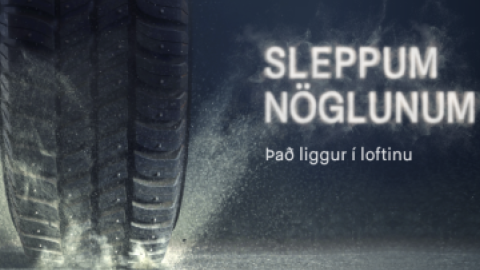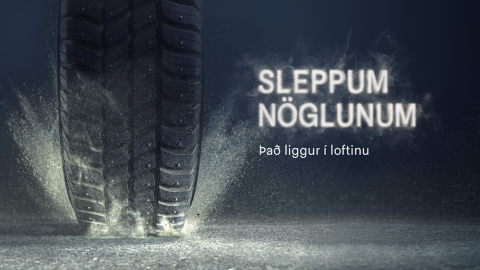Studded tires
Studded tires are not desirable on city streets for a number of reasons. They cause rapid and inevitable street erosion, and their operating costs are unnecessarily high. They create noise that could otherwise be prevented by choosing suitable winter tires instead. But worst of all, they emit particulates that contaminate people's respiratory systems and lungs. They also increase the fuel costs of vehicles. Therefore, it's crucial to reduce their usage.
The depth of tire tread plays a part in how much grip they have. As per the regulation on vehicle manufacture and equipment, a minimum tread depth of three millimeters is required on winter tires of personal cars. This is quite adequate for Reykjavík. While the use of studded tires is not banned from November 1 to April 15 every year, it's not recommended. Reykjavík City encourages drivers to think twice before fitting their cars with studded tires.
Let’s not use studs
More is not always better. Correct tires ensure the most safety, benefiting us all - ourselves, the streets, and the atmosphere. A lecture on the impact of studded tires on air quality and road deterioration revealed that studded tires were the major factor in contributing to suspended particulate pollution in the capital area. "A car with studded tires pollutes up to 40 times more than a car without studded tires," said Þorsteinn Jóhannsson, specialist at the Environment Agency, adding "That's times, not 20-40 percent more, but at least 2000 percent more."

The detriments of studded tires
The percentage of studded tires in October 2024 was 9.7%. This is slightly higher than the same time last year, when it was 7%. At the end of November 2023, the percentage of studded tires was 28.9%, and another count will be done at the same time this year.
The reality is that studded tires increase road maintenance costs in Reykjavík as they wear away the asphalt significantly faster than other tires. Not only do they raise vehicle fuel costs, but they also cause unnecessary noise and lower air quality due to pollution. For these reasons, it is crucial to reduce their use.

Reduction of studded tire use is necessary – research
Up to 67 premature deaths per year can be linked to suspended particulates. And studded tire use is a crucial contributor.
The dispersion of such particles throughout the street system in the capital area was investigated through models funded by the Road Construction Authority Research Fund. The study used the NORTRIP model to predict vehicular suspended particle emissions and provide indications for remedial action. One of the key findings of the report is the need to significantly reduce studded tire usage. A sensitivity analysis indicates that such usage is, by far, the most significant factor contributing to the formation of suspended particulates from traffic within the capital area.
The NORTRIP model (Non-Exhaust Road Traffic Induced Particle Emissions) was developed in the Nordic countries. It estimates the amount of suspended particulates (I. svifryk) in the atmosphere due to car traffic by simulating the processes of road dust particles.
The project took place from August 1, 2019, to July 1, 2020.
The report, titled "Processes and Modeling of Non-Exhaust Vehicular Emissions in the Icelandic Capital Region," was prepared by Brian C. Barr, a master's student at the University of Iceland's Earth Sciences Department. The project leader was Hrund Ó. Andradóttir, a professor at the University's Environmental and Civil Engineering Department. Brian delivered a lecture on the subject of the report at a Road Administration Research Conference in the fall of 2019.
What is suspended particulate matter?
Studded tires increase road maintenance costs in Reykjavík by eroding the asphalt at a much higher rate compared to other tires. They cause unwanted noise, negatively affect air quality through pollution, and also lead to higher fuel costs for vehicles. Research findings decisively suggest a significant increase in soot in suspended particulates over recent years, likely due to a substantial increase in traffic.


